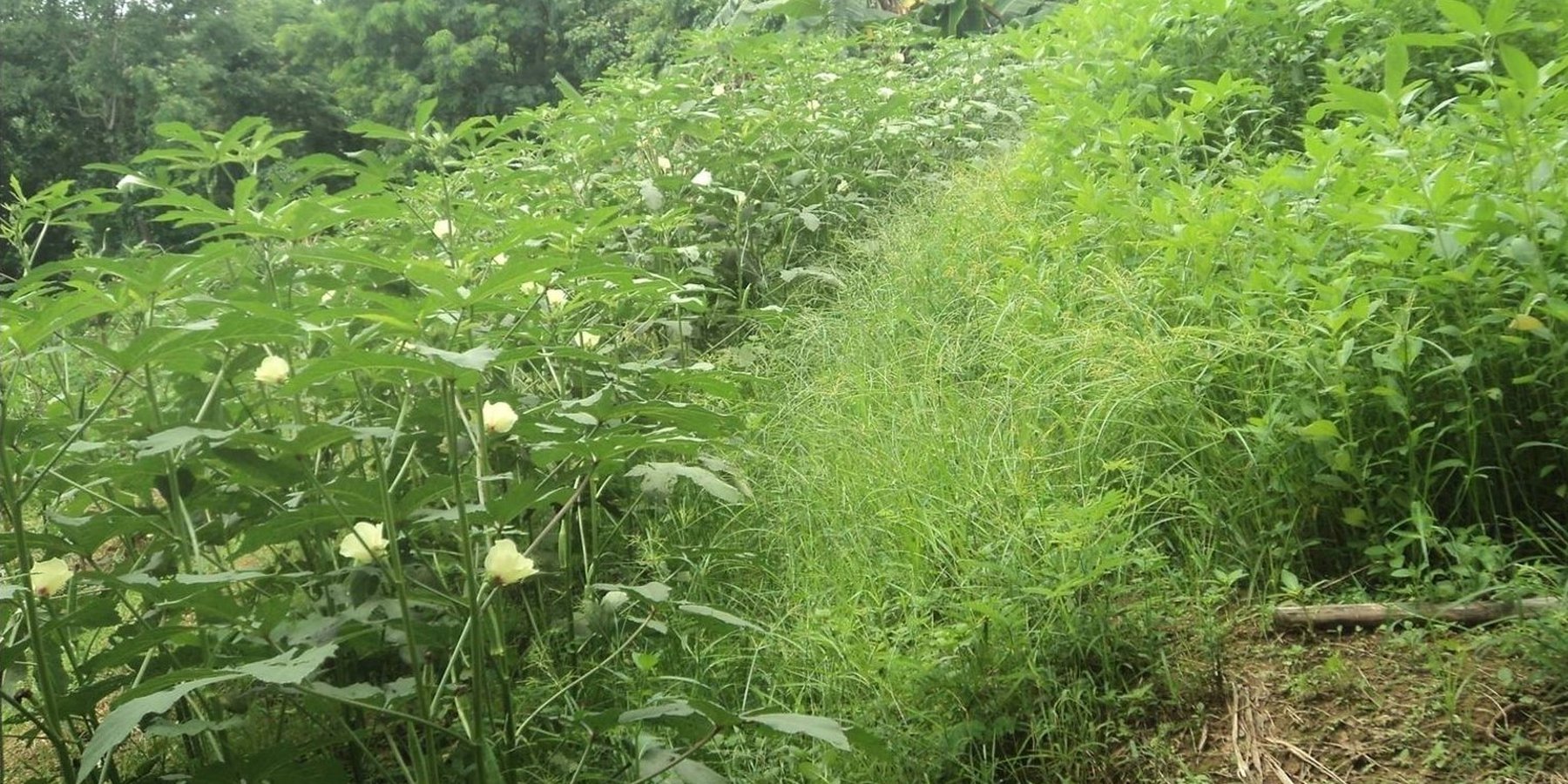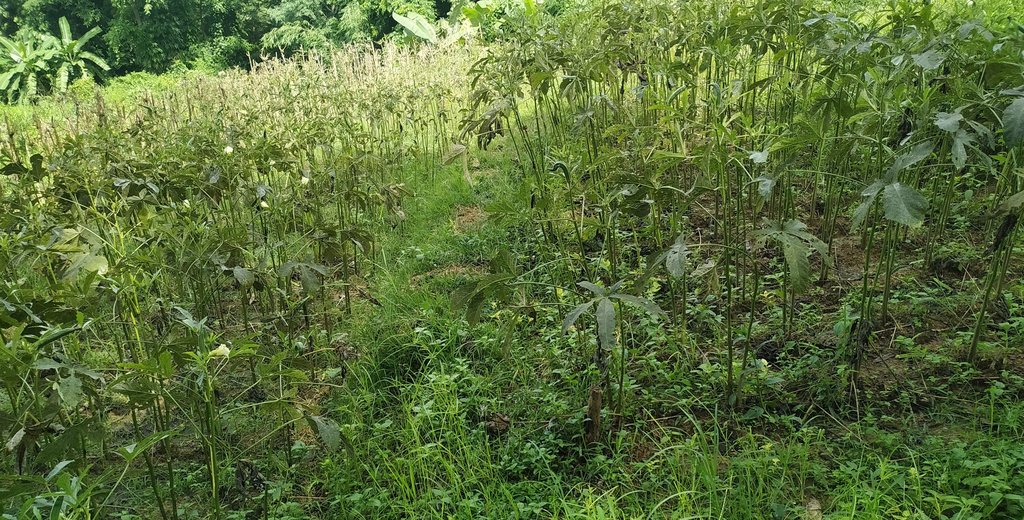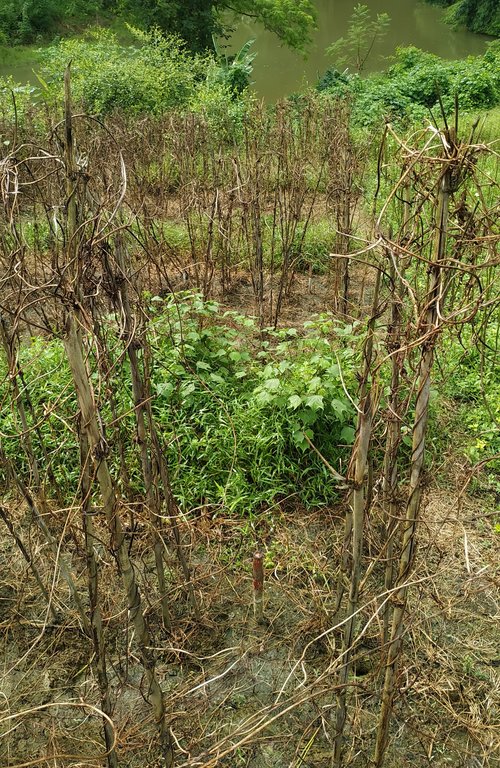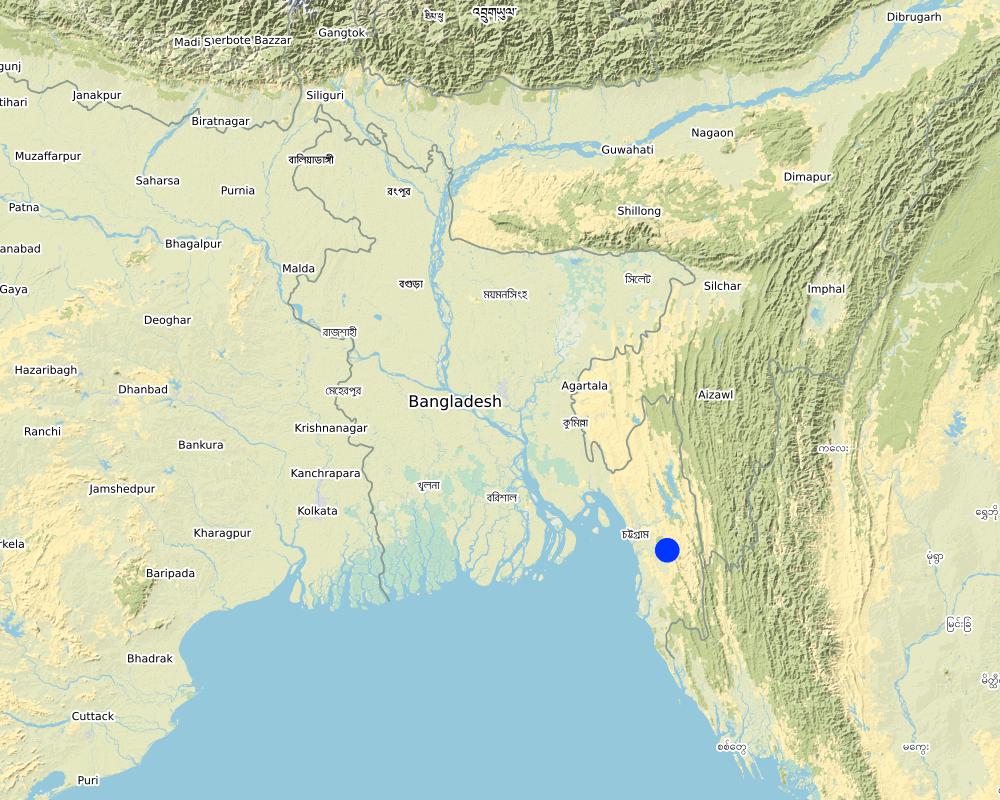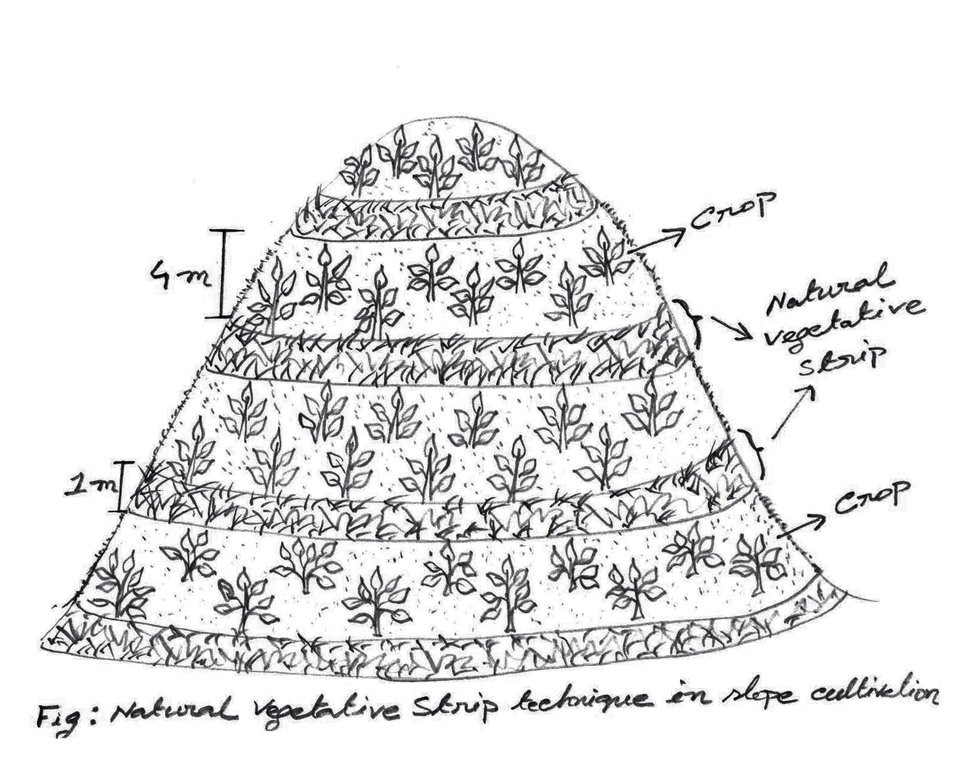Minimizing soil erosion through Natural Vegetative Strip (NVS) practice in slope cultivation [บังกลาเทศ]
- ผู้สร้างสรรค์:
- การอัพเดท:
- ผู้รวบรวม: Fazlay Arafat
- ผู้เรียบเรียง: –
- ผู้ตรวจสอบ: Rima Mekdaschi Studer, Ursula Gaemperli
technologies_5504 - บังกลาเทศ
ดูส่วนย่อย
ขยายทั้งหมด ย่อทั้งหมด1. ข้อมูลทั่วไป
1.2 รายละเอียดที่ติดต่อได้ของผู้รวบรวมและองค์กรที่เกี่ยวข้องในการประเมินและการจัดเตรียมทำเอกสารของเทคโนโลยี
วิทยากรหลัก
ผู้เชี่ยวชาญ SLM:
Islam Md. Mahbubul
Soil Conservation and Watershed Management Center
บังกลาเทศ
ผู้เชี่ยวชาญ SLM:
Islam Md. Shahinul
Soil Conservation and Watershed Management Center
บังกลาเทศ
ชื่อของโครงการซึ่งอำนวยความสะดวกในการทำเอกสารหรือการประเมินเทคโนโลยี (ถ้าเกี่ยวข้อง)
Decision Support for Mainstreaming and Scaling out Sustainable Land Management (GEF-FAO / DS-SLM)ชื่อขององค์กรซึ่งอำนวยความสะดวกในการทำเอกสารหรือการประเมินเทคโนโลยี (ถ้าเกี่ยวข้อง)
FAO Bangladesh (FAO Bangladesh) - บังกลาเทศชื่อขององค์กรซึ่งอำนวยความสะดวกในการทำเอกสารหรือการประเมินเทคโนโลยี (ถ้าเกี่ยวข้อง)
Soil Resource Development Institute (SRDI) (Soil Resource Development Institute (SRDI)) - บังกลาเทศ1.3 เงื่อนไขการใช้ข้อมูลที่ได้บันทึกผ่านทาง WOCAT
ผู้รวบรวมและวิทยากรหลักยอมรับเงื่อนไขเกี่ยวกับการใช้ข้อมูลที่ถูกบันทึกผ่านทาง WOCAT:
ใช่
1.4 การเปิดเผยเรื่องความยั่งยืนของเทคโนโลยีที่ได้อธิบายไว้
เทคโนโลยีที่ได้อธิบายไว้นี้เป็นปัญหาของความเสื่อมโทรมโทรมของที่ดินหรือไม่ จึงไม่ได้รับการยอมรับว่าเป็นเทคโนโลยีเพื่อการจัดการที่ดินอย่างยั่งยืน:
ไม่ใช่
2. การอธิบายลักษณะของเทคโนโลยี SLM
2.1 การอธิบายแบบสั้น ๆ ของเทคโนโลยี
คำจำกัดความของเทคโนโลยี:
Natural Vegetative Strips (NVS) are narrow strips of naturally growing grasses and herbs intentionally left unploughed along the contours of slope land to serve as buffers that prevent soil erosion during heavy rains.
2.2 การอธิบายแบบละเอียดของเทคโนโลยี
คำอธิบาย:
The Chittagong Hill Tracts (CHT) covers an area about 13,181 km2 and occupies about 76% of total 12% upland areas of the country and is endowed with natural beauty and potential economic benefits. Shifting cultivation or jhum has been practiced in CHT for many hundreds of years by the local people. Shifting cultivation is a form of agriculture, in which an area of ground is cleared of vegetation, and cultivated for a few years and then abandoned for a new area until its fertility has been naturally restored. Many cultivators practice slash-and-burn in jhum as one element of their farming cycle. Shifting cultivation and its associated fires destroyed about two thirds of the previously existing forests in CHT, which has accelerated soil erosion. While it was an environmentally suitable land use in the past when population pressure was low, it has gradually become an environmentally incompatible land use system with the shortening of fallow periods. In addition to increasing population pressure, low investment in agricultural technology, and poor management of land rights have also negatively impacted the forests. One of the best ways of adapting to these issues is the adoption of Natural Vegetative Strip (NVS) technique on cultivated slopes.
NVS are narrow strips of naturally growing grasses and herbs intentionally left unploughed along the contours of hilly-sloped lands. On gentle slopes, every 4-meters a 1-meter wide strip of NVS is made along the natural contours of the slope. These strips serve as buffers that prevent the soil from eroding during heavy rains and intensive cultivation. Over time, these strips form stable terraces along the contours. Vegetables and other crops can be cultivated in between two NVS.
The Soil Conservation and Watershed Management Center in Meghla, Bandarban has implemented demonstration plots of this sustainable land management technique. Here the use of NVS has improved morphological and reproductive characteristics. They reduced soil erosion by more than 90% and NVS’s were easy to establish as they were incorporated during land preparation, and thus required minimal labour. They did not entail additional cost, as there was no need for additional planting materials, since the grasses naturally grew on the farm.
In addition to minimizing soil erosion, NVS plays a vital role in improving plant growth, crop productivity, and fruit length and weight. The strips also filter pesticides, nitrates and soluble phosphorus thus prevent runoff. As they improve water infiltration during heavy rains, subsequent land preparation and crop management become easier. One limitation of NVS is that it reduces the available cropping area by about 10 to 15%, depending on the steepness of the slope. The steeper slope require more wide vegetative strips for erosion protection. Typically the strips do not cause weed problems as long as the farmers regularly cultivate within the NVS area and maintain a 50 cm buffer around the area. If farmer-maintenance is good, no weed problems occur. NVS is a promising practice to mitigate soil erosion and improve crop cultivation in CHT.
2.3 รูปภาพของเทคโนโลยี
2.5 ประเทศภูมิภาค หรือสถานที่ตั้งที่เทคโนโลยีได้นำไปใช้และได้รับการครอบคลุมโดยการประเมินนี้
ประเทศ:
บังกลาเทศ
ภูมิภาค/รัฐ/จังหวัด:
Bandarban District
ข้อมูลจำเพาะเพิ่มเติมของสถานที่ตั้ง :
Soil Conservation and Watershed Management Center, Meghla, Bandarban
ระบุการกระจายตัวของเทคโนโลยี:
- กระจายไปอย่างสม่ำเสมอในพื้นที่
If precise area is not known, indicate approximate area covered:
- < 0.1 ตร.กม.(10 เฮกตาร์)
Is/are the technology site(s) located in a permanently protected area?
ไม่ใช่
Map
×2.6 วันที่การดำเนินการ
ถ้าไม่รู้ปีที่แน่นอน ให้ระบุวันที่โดยประมาณ:
- น้อยกว่า 10 ปี (ไม่นานนี้)
2.7 คำแนะนำของเทคโนโลยี
ให้ระบุว่าเทคโนโลยีถูกแนะนำเข้ามาอย่างไร:
- ในช่วงการทดลองหรือการทำวิจัย
ความคิดเห็น (ประเภทของโครงการ เป็นต้น) :
The Soil Conservation and Watershed Management Center demonstrate the NVS technology in hill slope of Bandarban area to study the impact of this practice on erosion.
3. การจัดประเภทของเทคโนโลยี SLM
3.1 วัตถุประสงค์หลักของเทคโนโลยี
- ปรับปรุงการผลิตให้ดีขึ้น
- ลด ป้องกัน ฟื้นฟู การเสื่อมโทรมของที่ดิน
- ลดความเสี่ยงของภัยพิบัติ
3.2 ประเภทของการใช้ที่ดินในปัจจุบันที่ได้นำเทคโนโลยีไปใช้
Land use mixed within the same land unit:
ไม่ใช่

พื้นที่ปลูกพืช
- การปลูกพืชล้มลุกอายุปีเดียว
Annual cropping - Specify crops:
- fodder crops - grasses
- legumes and pulses - beans
- vegetables - other
จำนวนของฤดูเพาะปลูกต่อปี:
- 2
ระบุ:
Summer and Winter
Is intercropping practiced?
ใช่
If yes, specify which crops are intercropped:
Yard-long bean and Okra
Is crop rotation practiced?
ไม่ใช่
3.3 Has land use changed due to the implementation of the Technology?
Has land use changed due to the implementation of the Technology?
- No (Continue with question 3.4)
แสดงความคิดเห็น:
Shifting cultivation practiced in the slopes through slush and burn which triggered extreme soil erosion
3.4 การใช้น้ำ
การใช้น้ำของที่ดินที่มีการใช้เทคโนโลยีอยู่:
- น้ำฝนร่วมกับการชลประทาน
แสดงความคิดเห็น:
Manual irrigation in the dry period from the stream
3.5 กลุ่ม SLM ที่ตรงกับเทคโนโลยีนี้
- มาตรการปลูกพืชขวางความลาดชัน (cross-slope measure)
3.6 มาตรการ SLM ที่ประกอบกันเป็นเทคโนโลยี

มาตรการอนุรักษ์ด้วยวิธีพืช
- V2: หญ้าและไม้ยืนต้น
3.7 รูปแบบหลักของการเสื่อมโทรมของที่ดินที่ได้รับการแก้ไขโดยเทคโนโลยี

การกัดกร่อนของดินโดยน้ำ
- Wt (Loss of topsoil): การสูญเสียดินชั้นบนหรือการกัดกร่อนที่ผิวดิน
3.8 การป้องกัน การลดลง หรือการฟื้นฟูความเสื่อมโทรมของที่ดิน
ระบุเป้าหมายของเทคโนโลยีกับความเสื่อมโทรมของที่ดิน:
- ลดความเสื่อมโทรมของดิน
4. ข้อมูลจำเพาะด้านเทคนิค กิจกรรมการนำไปปฏิบัติใช้ ปัจจัยนำเข้า และค่าใช้จ่าย
4.1 แบบแปลนทางเทคนิคของเทคโนโลยี
ข้อมูลจำเพาะด้านเทคนิค (แบบแปลนทางเทคนิคของเทคโนโลยี):
Slope: 15-45%
NVS width: 1 meter. Along the natural contours of the slope
Cropping bed: 4 meter
ผู้เขียน:
Nazrin Sultana
4.2 ข้อมูลทั่วไปเกี่ยวกับการคำนวณปัจจัยนำเข้าและค่าใช้จ่าย
ให้ระบุว่าค่าใช้จ่ายและปัจจัยนำเข้าได้รับการคำนวณอย่างไร:
- ต่อพื้นที่ที่ใช้เทคโนโลยี
ระบุขนาดและหน่วยพื้นที่:
1 acre
If using a local area unit, indicate conversion factor to one hectare (e.g. 1 ha = 2.47 acres): 1 ha =:
1 acre = 0.4 ha
อื่นๆ หรือสกุลเงินประจำชาติ (ระบุ):
BDT
If relevant, indicate exchange rate from USD to local currency (e.g. 1 USD = 79.9 Brazilian Real): 1 USD =:
84.0
ระบุค่าเฉลี่ยของค่าจ้างในการจ้างแรงงานต่อวัน:
600 BDT
4.3 กิจกรรมเพื่อการจัดตั้ง
| กิจกรรม | Timing (season) | |
|---|---|---|
| 1. | Cleaning | March-April |
| 2. | Making contour line | March-April |
| 3. | Planting | April-May |
4.4 ค่าใช้จ่ายของปัจจัยนำเข้าที่จำเป็นสำหรับการจัดตั้ง
| ปัจจัยนำเข้า | หน่วย | ปริมาณ | ค่าใช้จ่ายต่อหน่วย | ค่าใช้จ่ายทั้งหมดต่อปัจจัยนำเข้า | %ของค่าใช้จ่ายที่ก่อให้เกิดขึ้นโดยผู้ใช้ที่ดิน | |
|---|---|---|---|---|---|---|
| แรงงาน | Cleaning | person-days | 15.0 | 600.0 | 9000.0 | 100.0 |
| แรงงาน | Making contour line | person-days | 8.0 | 600.0 | 4800.0 | 100.0 |
| แรงงาน | Making pit | person-days | 8.0 | 600.0 | 4800.0 | 100.0 |
| แรงงาน | Fertilizer application | person-days | 2.0 | 600.0 | 1200.0 | 100.0 |
| อุปกรณ์ | Spade, Knife, Basket | lump sum | 1.0 | 5000.0 | 5000.0 | 100.0 |
| วัสดุด้านพืช | Seeds of vegetables | kg | 0.6 | 4000.0 | 2400.0 | 100.0 |
| วัสดุด้านพืช | Bamboo stick to support plant | pcs | 1500.0 | 2.0 | 3000.0 | 100.0 |
| ปุ๋ยและสารฆ่า/ยับยั้งการเจริญเติบโตของสิ่งมีชีวิต (ไบโอไซด์) | Urea | kg | 450.0 | 16.0 | 7200.0 | 100.0 |
| ปุ๋ยและสารฆ่า/ยับยั้งการเจริญเติบโตของสิ่งมีชีวิต (ไบโอไซด์) | TSP | kg | 150.0 | 22.0 | 3300.0 | 100.0 |
| ปุ๋ยและสารฆ่า/ยับยั้งการเจริญเติบโตของสิ่งมีชีวิต (ไบโอไซด์) | MoP | kg | 200.0 | 15.0 | 3000.0 | 100.0 |
| ปุ๋ยและสารฆ่า/ยับยั้งการเจริญเติบโตของสิ่งมีชีวิต (ไบโอไซด์) | Cow dung | lump sum | 1.0 | 5000.0 | 5000.0 | 100.0 |
| ปุ๋ยและสารฆ่า/ยับยั้งการเจริญเติบโตของสิ่งมีชีวิต (ไบโอไซด์) | pesticides | lump sum | 1.0 | 2000.0 | 2000.0 | 100.0 |
| วัสดุสำหรับก่อสร้าง | Fencing | lump sum | 1.0 | 3000.0 | 3000.0 | 100.0 |
| อื่น ๆ | Transportation | Lump sum | 1.0 | 2000.0 | 2000.0 | |
| ค่าใช้จ่ายทั้งหมดของการจัดตั้งเทคโนโลยี | 55700.0 | |||||
| Total costs for establishment of the Technology in USD | 663.1 | |||||
แสดงความคิดเห็น:
The Soil Conservation and Watershed Management Center bear all the costs of this documented practice as land user
4.5 การบำรุงรักษาสภาพหรือกิจกรรมที่เกิดขึ้นเป็นประจำ
| กิจกรรม | ช่วงระยะเวลา/ความถี่ | |
|---|---|---|
| 1. | Maintenance of the natural vegetative strip (weeding the crop bed, repair the natural vegetative strip) | Before onset of the monsoon |
4.6 ค่าใช้จ่ายของปัจจัยนำเข้าและกิจกรรมที่เกิดขึ้นเป็นประจำที่ต้องการการบำรุงรักษา (ต่อปี)
| ปัจจัยนำเข้า | หน่วย | ปริมาณ | ค่าใช้จ่ายต่อหน่วย | ค่าใช้จ่ายทั้งหมดต่อปัจจัยนำเข้า | %ของค่าใช้จ่ายที่ก่อให้เกิดขึ้นโดยผู้ใช้ที่ดิน | |
|---|---|---|---|---|---|---|
| แรงงาน | weeding the crop bed and repair the natural vegetative strip | person-days | 5.0 | 600.0 | 3000.0 | 100.0 |
| ค่าใช้จ่ายทั้งหมดของการบำรุงรักษาสภาพเทคโนโลยี | 3000.0 | |||||
| Total costs for maintenance of the Technology in USD | 35.71 | |||||
4.7 ปัจจัยสำคัญที่สุดที่มีผลกระทบต่อค่าใช้จ่าย
ปัจจัยสำคัญที่สุดที่มีผลกระทบต่อค่าใช้จ่ายต่างๆ:
The cost depends on the slope. Steep slopes require more natural vegetative strips to reduce soil erosion. Hence, the cost is higher for steep slopes.
5. สิ่งแวดล้อมทางธรรมชาติและของมนุษย์
5.1 ภูมิอากาศ
ฝนประจำปี
- < 250 ม.ม.
- 251-500 ม.ม.
- 501-750 ม.ม.
- 751-1,000 ม.ม.
- 1,001-1,500 ม.ม.
- 1,501-2,000 ม.ม.
- 2,001-3,000 ม.ม.
- 3,001-4,000 ม.ม.
- > 4,000 ม.ม.
ระบุชื่อของสถานีตรวดวัดอากาศที่ใช้อ้างอิงคือ:
Bandarban
เขตภูมิอากาศเกษตร
- ชื้น
25.9 °C
5.2 สภาพภูมิประเทศ
ค่าเฉลี่ยความลาดชัน:
- ราบเรียบ (0-2%)
- ลาดที่ไม่ชัน (3-5%)
- ปานกลาง (6-10%)
- เป็นลูกคลื่น (11-15%)
- เป็นเนิน (16-30%)
- ชัน (31-60%)
- ชันมาก (>60%)
ธรณีสัณฐาน:
- ที่ราบสูง/ที่ราบ
- สันเขา
- ไหล่เขา
- ไหล่เนินเขา
- ตีนเนิน
- หุบเขา
ระดับความสูง:
- 0-100 เมตร
- 101-500 เมตร
- 501-1,000 เมตร
- 1,001-1,500 เมตร
- 1,501-2,000 เมตร
- 2,001-2,500 เมตร
- 2,501-3,000 เมตร
- 3,001-4,000 เมตร
- > 4,000 เมตร
ให้ระบุถ้าเทคโนโลยีได้ถูกนำไปใช้:
- ไม่เกี่ยวข้อง
5.3 ดิน
ค่าเฉลี่ยความลึกของดิน:
- ตื้นมาก (0-20 ซ.ม.)
- ตื้น (21-50 ซ.ม.)
- ลึกปานกลาง (51-80 ซ.ม.)
- ลึก (81-120 ซ.ม.)
- ลึกมาก (>120 ซ.ม.)
เนื้อดิน (ดินชั้นบน):
- ปานกลาง (ดินร่วน ทรายแป้ง)
เนื้อดินล่าง (> 20 ซ.ม.ต่ำจากผิวดิน):
- ปานกลาง (ดินร่วน ทรายแป้ง)
อินทรียวัตถุในดิน:
- ปานกลาง (1-3%)
5.4 ความเป็นประโยชน์และคุณภาพของน้ำ
ระดับน้ำใต้ดิน:
5-50 เมตร
น้ำไหลบ่าที่ผิวดิน:
ดี
คุณภาพน้ำ (ที่ยังไม่ได้บำบัด):
เป็นน้ำเพื่อการดื่มที่ไม่ดี (จำเป็นต้องได้รับการบำบัด)
Water quality refers to:
surface water
ความเค็มของน้ำเป็นปัญหาหรือไม่:
ไม่ใช่
กำลังเกิดน้ำท่วมในพื้นที่หรือไม่:
ไม่ใช่
5.5 ความหลากหลายทางชีวภาพ
ความหลากหลายทางชนิดพันธุ์:
- ปานกลาง
ความหลากหลายของแหล่งที่อยู่:
- ปานกลาง
5.6 ลักษณะของผู้ใช้ที่ดินที่นำเทคโนโลยีไปปฏิบัติใช้
อยู่กับที่หรือเร่ร่อน:
- อยู่กับที่
แนวทางการตลาดของระบบการผลิต:
- ทำการค้า/การตลาด
รายได้ที่มาจากนอกฟาร์ม:
- < 10% ของรายได้ทั้งหมด
ระดับของความมั่งคั่งโดยเปรียบเทียบ:
- พอมีพอกิน
เป็นรายบุคคล/ครัวเรือน:
- ลูกจ้าง (บริษัท รัฐบาล)
ระดับของการใช้เครื่องจักรกล:
- งานที่ใช้แรงกาย
เพศ:
- หญิง
- ชาย
อายุของผู้ใช้ที่ดิน:
- ผู้เยาว์
- วัยกลางคน
- ผู้สูงอายุ
ระบุลักษณะอื่นๆที่เกี่ยวข้องของผู้ใช้ที่ดิน:
Normally land users will apply the Technology as households or small groups. In the case here documented, the Soil Conservation and Watershed Management Center in Bandarban applied the technology for research purposes
5.7 Average area of land used by land users applying the Technology
- < 0.5 เฮกตาร์
- 0.5-1 เฮกตาร์
- 1-2 เฮกตาร์
- 2-5 เฮกตาร์
- 5-15 เฮกตาร์
- 15-50 เฮกตาร์
- 50-100 เฮกตาร์
- 100-500 เฮกตาร์
- 500-1,000 เฮกตาร์
- 1,000-10,000 เฮกตาร์
- >10,000 เฮกตาร์
พิจารณาว่าเป็นขนาดเล็ก กลาง หรือขนาดใหญ่ (ซึ่งอ้างอิงถึงบริบทระดับท้องถิ่น):
- ขนาดเล็ก
5.8 กรรมสิทธิ์ในที่ดิน สิทธิในการใช้ที่ดินและสิทธิในการใช้น้ำ
กรรมสิทธิ์ในที่ดิน:
- รัฐ
- เป็นแบบชุมชนหรือหมู่บ้าน
สิทธิในการใช้ที่ดิน:
- เกี่ยวกับชุมชน (ถูกจัดระเบียบ)
- เช่า
สิทธิในการใช้น้ำ:
- เข้าถึงได้แบบเปิด (ไม่ได้จัดระเบียบ)
Are land use rights based on a traditional legal system?
ใช่
ระบุ:
As per Chittagong Hill Tract regulation act
5.9 การเข้าถึงบริการและโครงสร้างพื้นฐาน
สุขภาพ:
- จน
- ปานกลาง
- ดี
การศึกษา:
- จน
- ปานกลาง
- ดี
ความช่วยเหลือทางด้านเทคนิค:
- จน
- ปานกลาง
- ดี
การจ้างงาน (เช่น ภายนอกฟาร์ม):
- จน
- ปานกลาง
- ดี
ตลาด:
- จน
- ปานกลาง
- ดี
พลังงาน:
- จน
- ปานกลาง
- ดี
ถนนและการขนส่ง:
- จน
- ปานกลาง
- ดี
น้ำดื่มและการสุขาภิบาล:
- จน
- ปานกลาง
- ดี
บริการด้านการเงิน:
- จน
- ปานกลาง
- ดี
6. ผลกระทบและสรุปคำบอกกล่าว
6.1 ผลกระทบในพื้นที่ดำเนินการ (On-site) จากการใช้เทคโนโลยี
ผลกระทบทางด้านเศรษฐกิจและสังคม
การผลิต
การผลิตพืชผล
แสดงความคิดเห็น/ระบุ:
Crop production increased as seeds are planted in a systematic way with proper spacing
การผลิตพืชที่ใช้เลี้ยงปศุสัตว์
แสดงความคิดเห็น/ระบุ:
the natural strip yields fodder
การผลิตของจากป่าทุกชนิดยกเว้นไม้
แสดงความคิดเห็น/ระบุ:
The natural strip can be potentially used for Broom grass cultivation
การเสี่ยงต่อความล้มเหลวในการผลิต
แสดงความคิดเห็น/ระบุ:
Each strip also act as a barrier for pest infestation
ความหลากหลายของผลิตภัณฑ์
แสดงความคิดเห็น/ระบุ:
Each strip can grow different types of crops
พื้นที่สำหรับการผลิต
แสดงความคิดเห็น/ระบุ:
production area reduced due to establishment of natural strip
การจัดการที่ดิน
ความเป็นประโยชน์และคุณภาพของน้ำ
ความต้องการน้ำจากการชลประทาน
แสดงความคิดเห็น/ระบุ:
Demand for irrigation water reduced as NVS reduces runoff and soil can hold more moisture
รายได้และค่าใช้จ่าย
ค่าใช่จ่ายของปัจจัยการผลิตทางการเกษตร
แสดงความคิดเห็น/ระบุ:
Cleaning and jungle cutting is not require for whole land. Thus it reduces cost.
รายได้จากฟาร์ม
ความหลากหลายของแหล่งผลิตรายได้
แสดงความคิดเห็น/ระบุ:
Non Timber Forest Product (NTFP) in natural strip also generates income
ผลกระทบด้านสังคมวัฒนธรรมอื่น ๆ
ความมั่นคงด้านอาหาร / พึ่งตนเองได้
โอกาสทางด้านสันทนาการ
แสดงความคิดเห็น/ระบุ:
The practice increase the aesthetic view
SLM หรือความรู้เรื่องความเสื่อมโทรมของที่ดิน
ผลกระทบด้านนิเวศวิทยา
วัฐจักรน้ำหรือน้ำบ่า
น้ำไหลบ่าที่ผิวดิน
แสดงความคิดเห็น/ระบุ:
Surface runoff reduces due to barriers of NVS
การระบายน้ำส่วนเกิน
น้ำบาดาลหรือระดับน้ำในแอ่งน้ำบาดาล
แสดงความคิดเห็น/ระบุ:
Groundwater recharge improved due to reduced surface runoff
การระเหย
ดิน
ความชื้นในดิน
การสูญเสียดิน
การสะสมของดิน
แสดงความคิดเห็น/ระบุ:
Soil accumulation increased and eventually formed terraces along the contour line
การหมุนเวียนและการเติมของธาตุอาหาร
อินทรียวัตถุในดิน/ต่ำกว่าดินชั้น C
ความหลากหลายทางชีวภาพของพืชและสัตว์
มวลชีวภาพ/เหนือดินชั้น C
ความหลากหลายทางชีวภาพของพืช
ชนิดพันธุ์ที่ให้ประโยชน์
ความหลากหลายของสัตว์
การจัดการศัตรูพืชและโรคพืช
ลดความเสี่ยงของภัยพิบัติ
ดินถล่ม/ ซากต่าง ๆ ที่ถูกพัดพามา
การปล่อยคาร์บอนและก๊าซเรือนกระจก
6.2 ผลกระทบนอกพื้นที่ดำเนินการ (Off-site) จากการใช้เทคโนโลยี
น้ำที่ใช้ประโยชน์ได้
ผลกระทบของก๊าซเรือนกระจก
6.3 การเผชิญและความตอบสนองของเทคโนโลยีต่อการเปลี่ยนแปลงสภาพภูมิอากาศที่ค่อยเป็นค่อยไป และสภาพรุนแรงของภูมิอากาศ / ภัยพิบัติ (ที่รับรู้ได้โดยผู้ใช้ที่ดิน)
การเปลี่ยนแปลงสภาพภูมิอากาศที่ค่อยเป็นค่อยไป
การเปลี่ยนแปลงสภาพภูมิอากาศที่ค่อยเป็นค่อยไป
| ฤดู | increase or decrease | เทคโนโลยีมีวิธีการรับมืออย่างไร | |
|---|---|---|---|
| อุณหภูมิประจำปี | เพิ่มขึ้น | ดี | |
| อุณหภูมิตามฤดูกาล | ฤดูร้อน | เพิ่มขึ้น | ดี |
| ฝนประจำปี | เพิ่มขึ้น | ดี | |
| ฝนตามฤดู | ฤดูฝน | เพิ่มขึ้น | ดี |
สภาพรุนแรงของภูมิอากาศ (ภัยพิบัติ)
ภัยพิบัติทางอุตุนิยมวิทยา
| เทคโนโลยีมีวิธีการรับมืออย่างไร | |
|---|---|
| พายุฝนประจำท้องถิ่น | ดี |
| พายุฝนฟ้าคะนองประจำท้องถิ่น | ดี |
ภัยพิบัติจากสภาพภูมิอากาศ
| เทคโนโลยีมีวิธีการรับมืออย่างไร | |
|---|---|
| ภัยจากฝนแล้ง | ปานกลาง |
| ไฟบนบก | ปานกลาง |
ภัยพิบัติทางชีวภาพ
| เทคโนโลยีมีวิธีการรับมืออย่างไร | |
|---|---|
| การบุกรุกของแมลง / หนอน | ปานกลาง |
6.4 การวิเคราะห์ค่าใช้จ่ายและผลประโยชน์ที่ได้รับ
ผลประโยชน์ที่ได้รับเปรียบเทียบกับค่าใช้จ่ายในการจัดตั้งเป็นอย่างไร (จากมุมมองของผู้ใช้ที่ดิน)
ผลตอบแทนระยะสั้น:
ด้านบวกเล็กน้อย
ผลตอบแทนระยะยาว:
ด้านบวกอย่างมาก
ผลประโยชน์ที่ได้รับเปรียบเทียบกับค่าใช้จ่ายในการบำรุงรักษาหรือต้นทุนที่เกิดขึ้นซ้ำอีก เป็นอย่างไร (จากมุมมองของผู้ใช้ที่ดิน)
ผลตอบแทนระยะสั้น:
ด้านบวก
ผลตอบแทนระยะยาว:
ด้านบวกอย่างมาก
6.5 การปรับตัวของเทคโนโลยี
- ครั้งเดียวหรือเป็นการทดลอง
Of all those who have adopted the Technology, how many did so spontaneously, i.e. without receiving any material incentives/ payments?
- 0-10%
แสดงความคิดเห็น:
The Soil Conservation and Watershed Management Center, Bandarban applied the technology for research purposes and found that the practice reduces up to 90% soil erosion in slope cultivation. The department of agricultural extension now planning to start piloting the practice in hill areas.
6.6 การปรับตัว
เทคโนโลยีได้รับการปรับเปลี่ยนเมื่อเร็วๆนี้ เพื่อให้ปรับตัวเข้ากับสภาพที่กำลังเปลี่ยนแปลงหรือไม่:
ไม่ใช่
6.7 จุดแข็ง / ข้อได้เปรียบ / โอกาสของเทคโนโลยี
| จุดแข็ง / ข้อได้เปรียบ / โอกาสในทัศนคติของผู้ใช้ที่ดิน |
|---|
| Natural Vegetative strips are easy to establish. They are incorporated during land preparation, and thus require minimal labor. |
| They do not entail additional cost as there is no need for additional planting materials. |
| The natural strip reduces top soil erosion and retain the soil fertility. |
| จุดแข็ง / ข้อได้เปรียบ / โอกาสในทัศนคติของผู้รวบรวมหรือวิทยากรหลัก |
|---|
| The natural strips filter pests and also acts as a barrier to fire. |
| The natural strips eventually formed terraces for crop cultivation. |
| The practice improve water infiltration during heavy rains. |
6.8 จุดอ่อน / ข้อเสียเปรียบ / ความเสี่ยงของเทคโนโลยีและวิธีการแก้ไข
| จุดอ่อน / ข้อเสียเปรียบ / ความเสี่ยงในทัศนคติของผู้ใช้ที่ดิน | มีวิธีการแก้ไขได้อย่างไร |
|---|---|
| The NVS reduces the available cropping area by about 10 to 15%. | Non timber forest products like Broom grass can be planted in the natural strip to generate additional income to the farmers |
| Farmers regularly need to maintain the weeds of natural strip otherwise it may spread in the productive areas and reduces crop yield. | If farmer-maintenance is good, no weed problems occur |
| จุดอ่อน / ข้อเสียเปรียบ / ความเสี่ยงในทัศนคติของผู้รวบรวมหรือวิทยากรหลัก | มีวิธีการแก้ไขได้อย่างไร |
|---|---|
| Steep slope requires more wide natural vegetative strips and reduces the production area | Eventually the NVS formed wide bench terrace and allow more space for cultivation |
7. การอ้างอิงและการเชื่อมต่อ
7.1 วิธีการและแหล่งข้อมูล
- ไปเยี่ยมชมภาคสนาม การสำรวจพื้นที่ภาคสนาม
Number of informants: 02
- การสัมภาษณ์ผู้เชี่ยวชาญด้าน SLM หรือผู้ชำนาญ
Number of informants: 03
- การเก็บรวบรวมมาจากรายงานและเอกสารที่มีอยู่
Number of report: 01
วันที่เก็บรวบรวมข้อมูล(ภาคสนาม) :
02/09/2019
7.2 การอ้างอิงถึงสิ่งตีพิมพ์
หัวข้อ, ผู้เขียน, ปี, หมายเลข ISBN:
Annual report 2018-2019, SOIL CONSERVATION & WATERSHED MANAGEMENT CENTER (SCWMC), SOIL RESOURCE DEVELOPMENT INSTITUTE (SRDI)
ชื่อเรื่อง ผู้เขียน ปี ISBN:
MINISTRY OF AGRICULTURE, GOVERNMENT OF THE PEOPLE’S REPUBLIC OF BANGLADESH
7.4 General comments
The questionnaire addressed all the key aspects of the technology
ลิงก์และโมดูล
ขยายทั้งหมด ย่อทั้งหมดลิงก์
ไม่มีลิงก์
โมดูล
ไม่มีโมดูล


